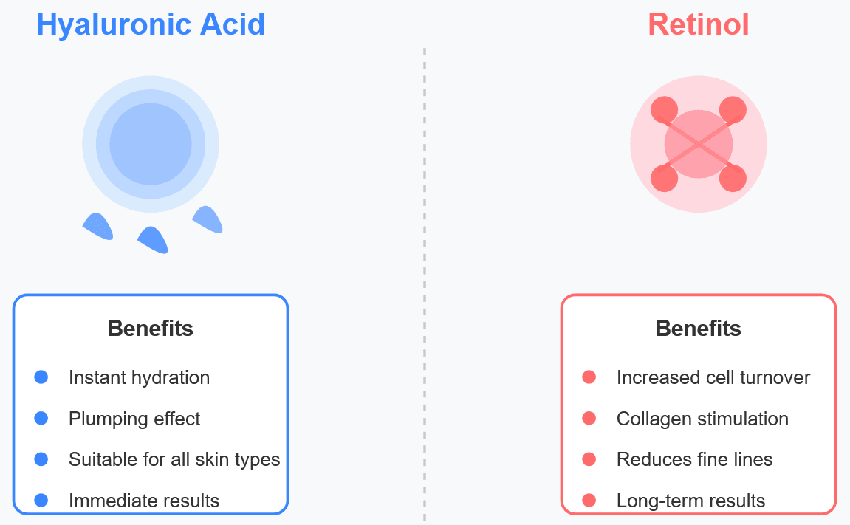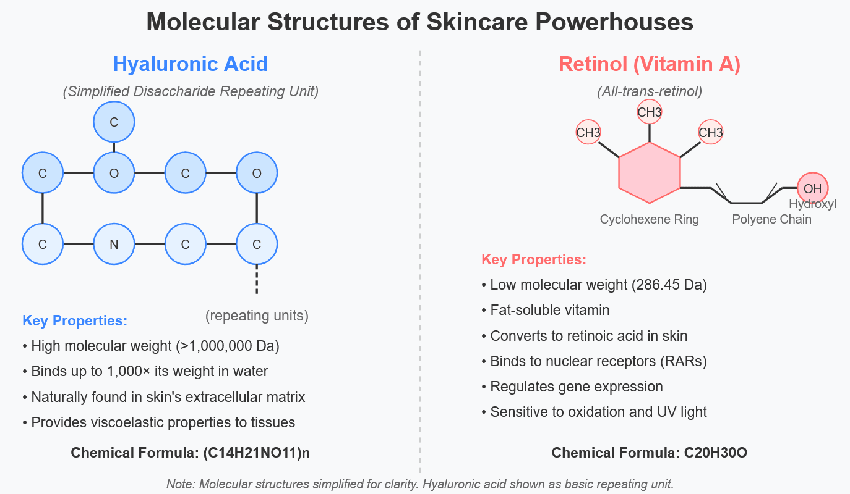Hyaluronic acid and retinol represent two distinct classes of dermatological agents with well-documented but different effects on the skin. These compounds demonstrate significant clinical utility in addressing age-associated skin changes through fundamentally different biochemical pathways—hyaluronic acid primarily functioning as a humectant with substantial water-binding capacity, while retinol acts as a cellular mediator promoting epidermal turnover and dermal remodeling (skin rebuilding).
“The most effective skincare routines are built on knowledge, not trends,” says Dr. Jennifer Hayes, board-certified dermatologist and clinical instructor. “Knowing whether hyaluronic acid or retinol—or both—belongs in your regimen requires understanding your skin’s unique needs and how these ingredients actually work.”
This comprehensive guide will walk you through everything you need to know about hyaluronic acid and retinol: their mechanisms of action, benefits, potential side effects, and how to incorporate them into your skincare practice for optimal results.
Understanding Hyaluronic Acid: Nature’s Moisture Magnet
Hyaluronic acid (HA) is a glycosaminoglycan, a type of sugar molecule naturally produced by the body. Found predominantly in the skin, eyes, and connective tissues, this remarkable substance possesses extraordinary hydrating properties.
The Science Behind Hyaluronic Acid
What makes hyaluronic acid exceptional is its unparalleled ability to attract and hold water molecules—up to 1,000 times its weight. This property makes it a superior humectant in skincare products.
“Hyaluronic acid functions as a molecular sponge,” explains cosmetic chemist Dr. Michelle Park. “When applied topically, it draws moisture from the environment into the skin’s upper layers, creating an immediate plumping effect.”
Our bodies naturally produce hyaluronic acid, with approximately 50% concentrated in our skin. However, production gradually decreases with age, dropping significantly after age 30. This decline contributes to the development of fine lines, decreased elasticity, and a generally duller complexion.
Key Benefits of Hyaluronic Acid
Hyaluronic acid offers numerous benefits that explain its popularity in skincare formulations:
- Intense Hydration: By drawing moisture into the skin, HA helps maintain optimal hydration levels, which is essential for all skin functions.
- Plumping Effect: The influx of moisture temporarily plumps the skin, reducing the appearance of fine lines and wrinkles.
- Barrier Support: Proper hydration strengthens the skin barrier, protecting against environmental aggressors and preventing moisture loss.
- Universal Compatibility: Unlike many active cosmetic ingredients, hyaluronic acid works well for virtually all skin types, including sensitive and acne-prone.
- Rapid Results: Effects can be noticed almost immediately after application, with skin appearing more hydrated and luminous.
According to research from the Journal of Drugs in Dermatology, topical application of hyaluronic acid can increase skin hydration by up to 96% within hours, with sustained effects when used consistently.
Retinol: The Gold Standard for Anti-Aging
Retinol, a derivative of vitamin A, has earned its reputation as the gold standard in anti-aging skincare through decades of research and proven results. Unlike hyaluronic acid, which primarily addresses hydration, retinol works at a cellular level to transform skin.
The Science Behind Retinol
When applied topically, retinol penetrates the outer skin layer (epidermis) and converts to retinoic acid in the deeper layers (dermis). Once converted, it binds to specific cell receptors, initiating a cascade of cellular processes that enhance skin renewal and repair.
“Retinol essentially ‘teaches’ skin cells to behave like younger, healthier versions of themselves,” notes Dr. Leslie Baumann, author of “The Skin Type Solution” and former Professor of Dermatology at the University of Miami. “It accelerates cellular turnover and stimulates collagen production, addressing multiple signs of aging simultaneously.”
Key Benefits of Retinol
Retinol’s multi-faceted approach to skin improvement includes:
- Accelerated Cell Turnover: By speeding up the skin’s natural exfoliation process, retinol helps shed dull, damaged cells and replace them with healthier ones.
- Collagen Stimulation: Research published in JAMA Dermatology demonstrates that retinol increases collagen production, improving skin firmness and reducing wrinkle depth.
- Pore Refinement: Regular use helps normalize cell turnover within pores, reducing their appearance and preventing congestion.
- Pigmentation Improvement: Retinol helps fade dark spots and hyperpigmentation by inhibiting melanin production and accelerating the removal of pigmented cells.
- Acne Management: Its ability to prevent follicular plugging makes retinol effective for treating and preventing acne breakouts.
Studies conducted at the University of Michigan Medical School have shown that retinol application can increase epidermal thickness by as much as 40% and increase collagen production by up to 80% over 12 weeks of consistent use.

Comparing Effects: Immediate vs. Long-Term Results
One of the most significant distinctions between hyaluronic acid and retinol lies in their timeline of visible results.
Hyaluronic Acid: The Instant Gratifier
Hyaluronic acid delivers almost immediate results. Within minutes of application, skin appears more hydrated, plumper, and smoother. These effects persist as long as the product remains on the skin, typically fading within 24 hours as the molecule is naturally broken down.
“Hyaluronic acid provides what I call ‘event-ready skin,'” says celebrity esthetician Joanna Vargas. “It’s perfect for quick results before special occasions or whenever your skin needs a hydration boost.”
While long-term use helps maintain optimal skin hydration, hyaluronic acid doesn’t permanently alter skin structure or function. Its benefits, though valuable, remain primarily surface-level and temporary.
Retinol: The Long-Game Champion
Retinol, by contrast, requires patience. Initial improvements—typically a subtle glow and smoother texture—may appear within a few weeks, but the most dramatic results develop over months of consistent use.
According to research published in the Archives of Dermatology, significant improvements in fine lines and wrinkles typically emerge after 12 weeks of regular retinol application, with continued enhancement seen even after 52 weeks.
“Retinol represents an investment in your skin’s future,” explains Dr. Ranella Hirsch, a board-certified dermatologist based in Boston. “While it doesn’t provide instant gratification, its ability to fundamentally improve skin quality makes it unparalleled for long-term anti-aging benefits.”
Potential Drawbacks and Side Effects
Neither ingredient is without potential drawbacks, which vary considerably between the two.
Hyaluronic Acid: Generally Gentle
Hyaluronic acid boasts an impressive safety profile, with adverse reactions extremely rare. As a substance naturally present in the body, it rarely triggers irritation or allergic responses.
The primary consideration involves proper application technique. In extremely dry environments, improperly used hyaluronic acid can potentially draw moisture from deeper skin layers rather than from the atmosphere, potentially exacerbating dryness.
“Always apply hyaluronic acid to damp skin and follow with a moisturizer to seal in hydration,” advises Dr. Park. “This ensures the molecule pulls water toward your skin rather than from it.”
Retinol: The Adjustment Period
Retinol’s potent effects come with a higher potential for side effects, particularly during the initial weeks of use. Common reactions include:
- Redness and irritation
- Peeling and flaking
- Increased sensitivity to sunlight
- Temporary worsening of acne (purging)
- Dryness
These effects, collectively known as “retinization,” typically subside as skin acclimates to the ingredient. According to the American Academy of Dermatology, proper introduction techniques can significantly minimize these reactions.
Complementary Rather Than Competitive
Perhaps the most important insight for skincare enthusiasts is that hyaluronic acid and retinol need not be viewed as competitors but rather as complementary ingredients addressing different skin needs.
“The most effective skincare routines often incorporate both ingredients,” says cosmetic formulator and founder of BeautyStat, Ron Robinson. “Retinol works to enhance skin renewal and structure, while hyaluronic acid ensures adequate hydration—creating a comprehensive approach to skin health.”
Many dermatologists recommend using hyaluronic acid in the morning for all-day hydration and retinol in the evening for overnight renewal. This approach maximizes benefits while working within each ingredient’s optimal application window.

How to Incorporate Both Into Your Routine
Creating a routine that includes both ingredients requires strategic planning:
Morning Routine:
- Cleanse with a gentle, non-stripping cleanser
- Apply hyaluronic acid serum to damp skin
- Follow with moisturizer to seal in hydration
- Finish with broad-spectrum SPF 30+ (particularly important when using retinol)
Evening Routine:
- Double cleanse with makeup removers to remove sunscreen and daily build-up
- Apply retinol product to completely dry skin (start with 1-2 times weekly, gradually increasing frequency)
- Wait 20-30 minutes for absorption
- Apply hyaluronic acid serum for hydration
- Finish with a nourishing night cream or facial oil
For retinol beginners, the “sandwich method” can help minimize irritation:
- Apply moisturizer
- Wait 15 minutes
- Apply retinol
- Wait 15 minutes
- Apply moisturizer again
Who Should Use Which Ingredient?
While both ingredients offer universal benefits, certain skin types and concerns may prioritize one over the other:
Ideal Candidates for Hyaluronic Acid:
- Dehydrated skin (regardless of whether it’s oily or dry)
- Sensitive skin that cannot tolerate active ingredients
- Rosacea-prone skin needing non-irritating hydration
- Younger individuals focusing on prevention
- Anyone seeking immediate improvement for special occasions
Ideal Candidates for Retinol:
- Those concerned with signs of aging (fine lines, wrinkles, loss of firmness)
- Individuals with sun damage and hyperpigmentation
- Acne-prone skin (particularly adult acne)
- People in their late 20s and beyond looking for preventative and corrective benefits
Learn about the difference between hyaluronic acid vs. retinol.
The Bottom Line
Both hyaluronic acid and retinol have earned their stellar reputations in the skincare world through substantial scientific evidence and consistent results. Rather than choosing between them, consider how they might work together to address your unique skin concerns.
As with all skincare decisions, consultation with a dermatologist can provide personalized guidance based on your specific skin type, concerns, and goals. What works beautifully for one person may not be ideal for another, making professional advice invaluable when crafting your optimal skincare routine.
Hyaluronic Acid vs Retinol References
- Wang F, et al. “Improvement of photodamaged skin by topical retinol (retinyl palmitate): a vehicle-controlled, double-blind study.” Archives of Dermatology. 2010;146(6):659-666.
- Papakonstantinou E, et al. “Hyaluronic acid: A key molecule in skin aging.” Dermato-Endocrinology. 2012;4(3):253-258. https://www.ncbi.nlm.nih.gov/pmc/articles/PMC3583886/
- National Institute on Aging. “Skin Care and Aging.” https://www.nia.nih.gov/health/skin-care-and-aging
- U.S. Food and Drug Administration. “Alpha Hydroxy Acids & Hyaluronic Acid in Skincare Products.” https://www.fda.gov/cosmetics/cosmetic-ingredients/alpha-hydroxy-acids
- Zasada M, Budzisz E. “Retinoids: active molecules influencing skin structure formation in cosmetic and dermatological treatments.” Postepy Dermatologii i Alergologii. 2019;36(4):392-397. https://www.ncbi.nlm.nih.gov/pmc/articles/PMC6791161/
- Retinoids: active molecules influencing skin structure
- Use of Retinoids in Topical Antiaging Treatments
- Wrinkle Treatments and Other Anti-aging Products
- Hyaluronic acid: A key molecule in skin aging – PMC
- Advantages of Hyaluronic Acid and Its Combination

